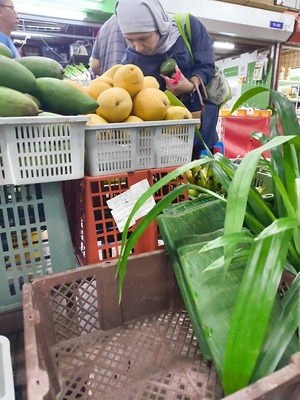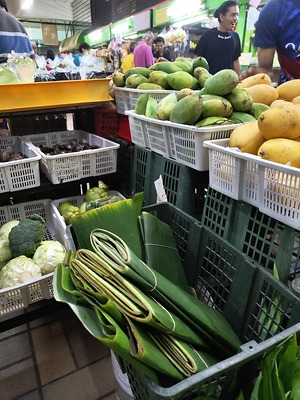


Banana Leaves
Estimated Inventory, ea : 0
Description/Taste
Banana leaves are large in size, ranging from 30 to 50 centimeters in width and reaching up to two meters in length, and have a wide-spreading, elongated nature. There are approximately 8 to 12 leaves per plant, and each leaf is broad, flat, and cylindrical with rounded edges. The front, also known as the top of the leaf blade, has a dark green, smooth, waxy, and glossy surface. The underside of the leaf, also known as the back, has a more muted, pale green hue and matte appearance. Banana leaves are waterproof, and a central midrib runs the length of the leaf, creating two laminas, or leaf halves, found on either side of the midrib. It is important to note that Banana leaves do not have branching veins, making them vulnerable to tearing easily. When selecting fresh Banana leaves, look for leaves that are dark green, flexible, and intact with smooth edges. The leaves are not consumed and are discarded after cooking. Banana leaves are used as a food wrap and impart a subtly sweet, grassy, green, and vegetal flavor.
Seasons/Availability
Banana leaves are available year-round.
Current Facts
Banana leaves, botanically a part of the Musa genus, are the large, wide-spreading greens crowning the herbaceous flowering plant belonging to the Musaceae family. Bananas are one the cheapest and most cultivated crops worldwide, and there are many different varieties of the plant, with some cultivars growing 7 to 8 meters in height. Unlike the fruits, Banana leaves are a secondary crop that is not commercially produced. The leaves are gathered from wild plants, home garden trees, or plantations and have historically been used as a natural tablecloth, flattened as a plate, used as packaging, or packaged into a cup-like vessel for liquids. Banana leaves are also used to wrap food to impart a subtle flavor and aroma, and culturally, the large leaves were once utilized as a writing surface, stripped of their fibers and woven, used as an umbrella, or combined with other materials in construction. Outside of tropical and subtropical regions, Banana leaves are one of the lesser-known elements of a banana plant, but they are increasing in notoriety and popularity as a multi-purpose, natural, and eco-friendly culinary tool.
Nutritional Value
Banana leaves are not edible as they have a high fiber content, making them too challenging to digest. In Southeast Asia, the leaves are used to make juices, tea, and various tinctures to reduce symptoms associated with colds, heat stroke, and coughs. Banana leaves are also used topically to reduce skin irritations, and the leaves are covered in coconut oil and placed over blisters as a wound dressing. The juice is a source of polyphenols, natural compounds with antioxidant-like properties to protect the cells against free radicals and oxidative stress damage. Antioxidants also have anti-inflammatory properties to help reduce irritation and inflammation.
Applications
Banana leaves are not consumed, but they are famously used as a wrap for food. The large leaves can be folded to enclose various foods, trapping in moisture with their waterproof nature. Banana leaves also help to soften tough cuts of meat and impart a subtly sweet and grassy flavoring to its filling. Meats, sticky rice, vegetables, tamales, and other ingredients are folded into Banana leaves, and the small packages can be steamed, grilled, smoked, or deep fried. In Southeast Asia, Banana leaves are used for cooking nasi lemak in Malaysia, a rice dish flavored with pandan leaf and coconut milk, and lontong in Indonesia, a flattened rice cake. In the Philippines, bibingka is a coconut and rice cake baked in Banana leaves, and in India, Banana leaves are used to make curries, paneer, rice, and vegetables. Panki is a popular dish in Gujarat, India, where batter is grilled on a Banana leaf to create a warm snack. Outside of Southeast Asia, Banana leaves are also used in Polynesia to wrap roasted meats, including whole pigs, and are incorporated as food wraps for cooked meats, starches, and vegetables throughout South America, Africa, and other tropical and subtropical communities worldwide. Whole, unwashed Banana leaves will keep up to one week when stored in a sealed container in the refrigerator, but it is recommended to use them within three days for the best quality and flavor. The leaves can also be frozen for up to six months.
Ethnic/Cultural Info
In Thailand, Banana leaves are hand-woven into intricate floating vessels and used to carry away bad luck and negative energy in the festival of Loi Krathong, also known as The Festival of Light. The annual celebration occurs on the night of the full moon in the 12th month of the Thai lunar calendar and is a time of honoring Mae Kongkha, the Water Goddess. Loi Krathong also marks the end of the harvest season, specifically for rice, and Thai people give thanks to the goddess for the current harvest, hope for blessings in the future harvest, and ask for forgiveness for the pollution they may have caused over the past year. One of the main rituals during the festival is the creation and release of the krathong, a floating raft-like vessel. Krathongs are traditionally constructed from Banana leaves, and the large leaves are folded, sewn, and woven to create small rafts in all shapes and designs. Once the vessel is complete, it is adorned with candles, incense, flowers, and personal items and is released into the ocean as a symbolic gesture of releasing bad energy, grudges, and anger. The practice of releasing krathongs is tied to 14th-century king Sukhothai when his wife made a lotus flower krathong and offered it to the king. Legend has it that Sukhothai took the krathong and floated it on the water, beginning the celebratory tradition. In general, the use of Banana leaves allows festival attendees to cleanse and wash away evil from their lives and is thought to welcome happiness, good luck, and joy. The leaves are also natural and will decompose in the water, ensuring that the ocean is not polluted with any unnatural elements.
Geography/History
Banana leaves are native to Southeast Asia and have been growing wild since ancient times. Banana plants were an essential crop among early civilizations, and over time, different varieties of bananas were selected from the wild and domesticated into a commercial fruit. Bananas were spread throughout tropical and subtropical regions worldwide through explorers, trade routes, and immigration, and since their global introduction, they have become one of the most cultivated fruits. Despite the banana's popularity, Banana leaves are a secondary crop that is not commercially produced. The leaves are primarily sourced from trees used for fruit cultivation worldwide and are utilized as a serving plate, decorative element, food wrap, and cooking element. Today Banana leaves can be found in tropical to subtropical climates worldwide and are sold through fresh markets, select grocers, and specialty distributors. The leaves are also foraged from wild trees in regions where bananas have naturalized.
Recipe Ideas
Recipes that include Banana Leaves. One
| The Ravenous Couple |
|
Banh Gio Steamed Minced Pork and Rice Dumpling |
Podcast

















